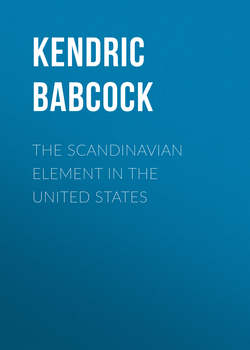The Scandinavian Element in the United States

Реклама. ООО «ЛитРес», ИНН: 7719571260.
Оглавление
Babcock Kendric Charles. The Scandinavian Element in the United States
CHAPTER I. Introduction
CHAPTER II. Swedes, Norwegians, and Danes
CHAPTER III. Early Norwegian Immigration
CHAPTER IV. The Rising Stream of Norwegian Immigration
CHAPTER V. Swedish Immigration Before 1850
CHAPTER VI. The Danish Immigration
CHAPTER VII. A Half Century of Expansion and Distribution, 1850-1900
CHAPTER VIII. Economic Forces at Work
CHAPTER IX. The Religious and Intellectual Standpoint
CHAPTER X. Social Relations and Characteristics
CHAPTER XI. The Scandinavian in Local and State Politics
CHAPTER XII. Party Preferences and Political Leadership
CHAPTER XIII. Conclusion
CHAPTER XIV. Critical Essay on Materials and Authorities
APPENDIX I. Statistical Tables
APPENDIX II
Отрывок из книги
The common use of the term Scandinavian to describe Swedes, Norwegians, and Danes in a broad and general way, is one of the products of the commingling of these three peoples on the American side of the Atlantic. The word really fits even more loosely than does the word British to indicate the English, Welsh and Scotch. It was applied early in the history of the settlements in Wisconsin and Illinois, to groups which comprised both Norwegians and Danes on the one hand, or Norwegians and Swedes on the other hand, when no one of the three nationalities was strong enough to maintain itself separately, and when the members of one were inclined, in an outburst of latent pride of nationality, not to say conceit of assumed superiority, to resent being called by one of the other names; for example, when a Norwegian objected to being taken for a Swede. Thus the Scandinavian Synod of the Evangelical Lutheran Church, organized in 1860, included both Norwegians and Danes; ten years later the name was changed to the Norwegian-Danish Conference; and in 1884 the differentiation was carried further, and the Danes formed a new Danish Evangelical Lutheran Church Association, supplementing the Danish Evangelical Lutheran Church in America, which dated back to 1871.
Vigorous protests were made from time to time against the use of “Skandinavian” or “Skandinav.” “Shall we Norwegians let the Danes persist in calling us Scandinavians?” wrote “Anti-Skandinavian” to the leading American Norwegian weekly of 1870.9 He also quoted the sarcastic words of Ole Bull: “Scandinavia, gentlemen, – may I ask where that land lies? It is not found in my geography; does it lie perhaps in the moon?”10 But the use and acceptability of the word steadily grew; the great daily paper in Chicago took the name Skandinaven; in 1889, the editor of The North declared: “The term has become a household word … universally understood in the sense in which we here use it (to designate the three nationalities).”11
.....
In all three countries, as in the rest of Europe, changes in commercial, industrial, social, legal, and religious matters were sure to be slow. The tenure and succession in lands, the limited market for labor, the relatively small opportunity for initiative, especially for the younger members of considerable families, – all of these conditions with the characteristics already described, lent added attractiveness to the call of the American West.
These letters scattered through western Norway from 1830 to 1840, were as seed sown in good ground. Times were hard; money was scarce and its value fluctuating.45 The crops were often short, the prices of grain were high, and the demand for the labor of the peasants was weak; the economic conditions of the lower classes, especially in the rural districts – much the greater part of the country – were growing worse rather than better.46 Even the oldest son, who was heir to his father’s homestead, was likely to find himself possessed of a debt-burdened estate and with the necessity of providing for the mother and numerous younger children.47 The younger sons, being still worse off, were forced to try their hands at various occupations to earn a bare living. Ole Nattestad, already mentioned, was by turns before his emigration farmer, peddler, blacksmith, and sheep-buyer.48 To many a man with a large family of growing children the possibility of disaster in the United States was less forbidding than the probability of ultimate failure in Norway.
.....